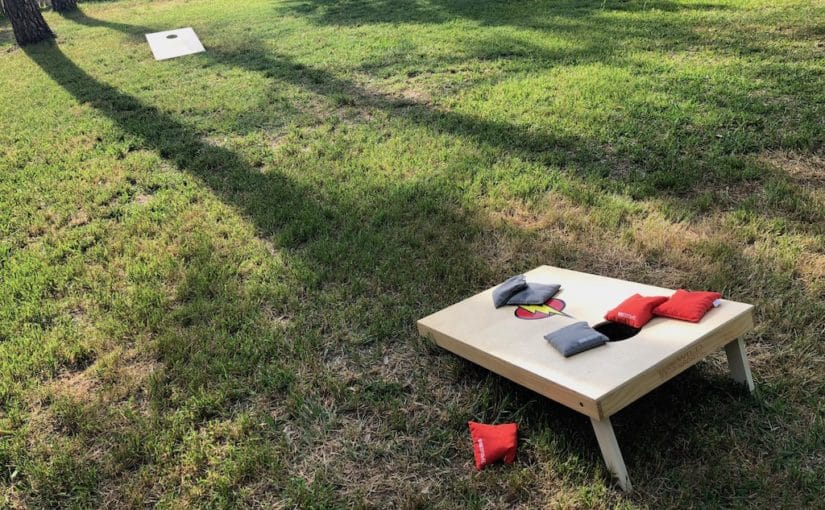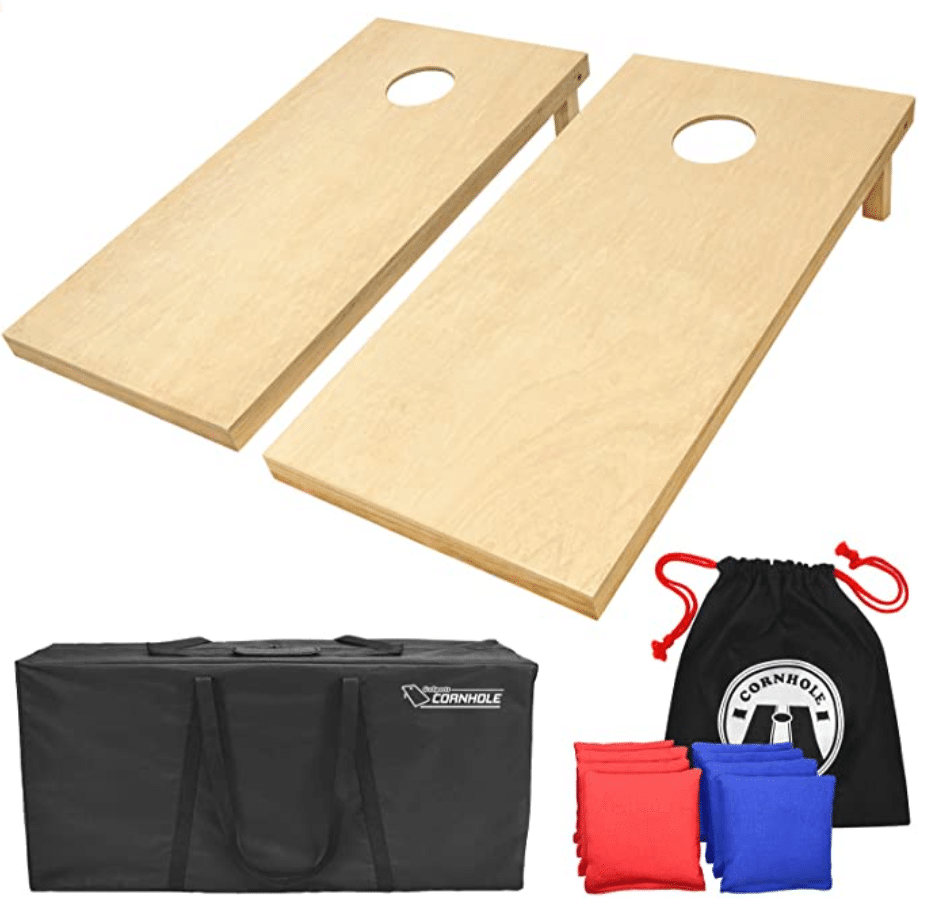There are two main sources for cornhole rules that people use: The American Cornhole Organization (ACO) and The American Cornhole Association (ACA). I personally prefer the ACO’s rules and so I’ll be basing these cornhole rules on those and will be noting where I also mention rules by the ACA.
In the end, both sets of rules are very similar so the differences aren’t a big deal — I just wanted to let you know where I’m getting these rule from.
Cornhole court
The first cornhole rule that you need be aware of is how to set up an official cornhole court.
Get a quality cornhole board set right now!
Check out my #1 recommendation for a quality cornhole board set that is perfect for beginners.
Official cornhole court dimensions
Below are the dimensions needed for an official sized cornhole court, which is 8 feet by 45 feet (The ACA goes with 10 feet by 45 feet).
If you don’t have that much room that’s okay, but you’ll want to try to at least have enough room to set up the cornhole boards the appropriate distance from each other.
Cornhole boards should be approximately 27 feet apart from each other, measured from edge to edge as shown in the diagram below.
Juniors (aka kids) are allowed to throw from 21 feet away from the cornhole boards and the ACA also permits for seniors or disabled folks to throw from that distance when agreed. When throwing from that distance, the players don’t have to remain in pitchers boxes.
If you’re just playing backyard or tailgate style cornhole, know that many people settle for 24 feet apart from each other.
If you are playing with multiple cornhole courts like some tournaments do then you’ll want to have around 10 to 12 feet between the cornhole courts.
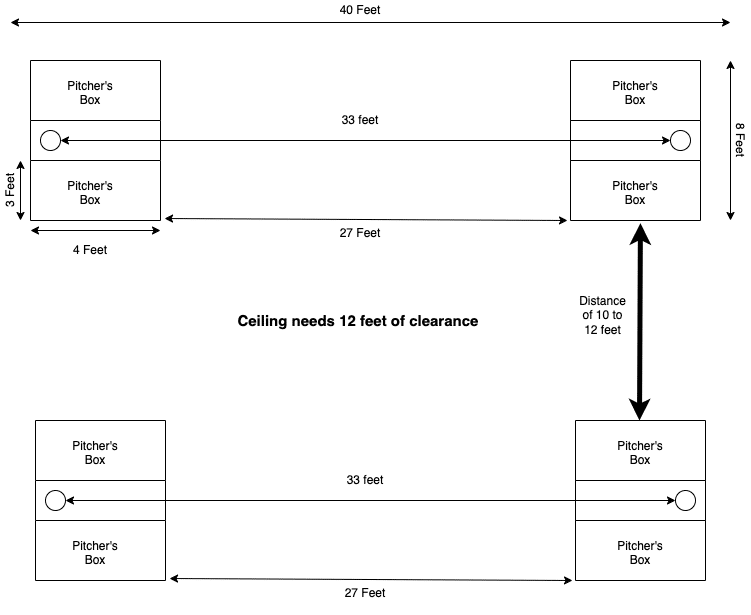
If you are playing indoors then you need to make sure that you have at least 12 feet of clearance between the floor and the ceiling. The ACO allows for less clearance but states that players must be given notice about that.
Cornhole foul lines and pitchers boxes
The cornhole foul line is an imaginary line that runs from the front of the cornhole board on either side. You are not permitted to step over this line when you throw your bag or else that will be considered a foul and your bag will be worth zero points.
The pitchers boxes are 3 feet by 4 four feet and these were the designated areas where you are supposed to pitch your bag from.

Cornhole boards
A regulation-sized cornhole board is a wooden board 48 inches by 24 inches.
The thickness of the playing surface (which is the cornhole board with the hole) should be 1/2” with cross-section backing or 3/4” with or without cross-section backing. It’s usually made of plywood (usually birch), but you can choose different types of wood for your cornhole board.
The cornhole should be 6” in diameter and centered 9” from the top of the board and centered from each side edge. The front of the board is 3” to 4” from the ground to the top of the playing surface while the back of the board is 12” from the ground to the top of the playing surface.
The board in a set should weigh no less than 25 pounds.
The diagrams below illustrate what the proper cornhole board dimensions look like.
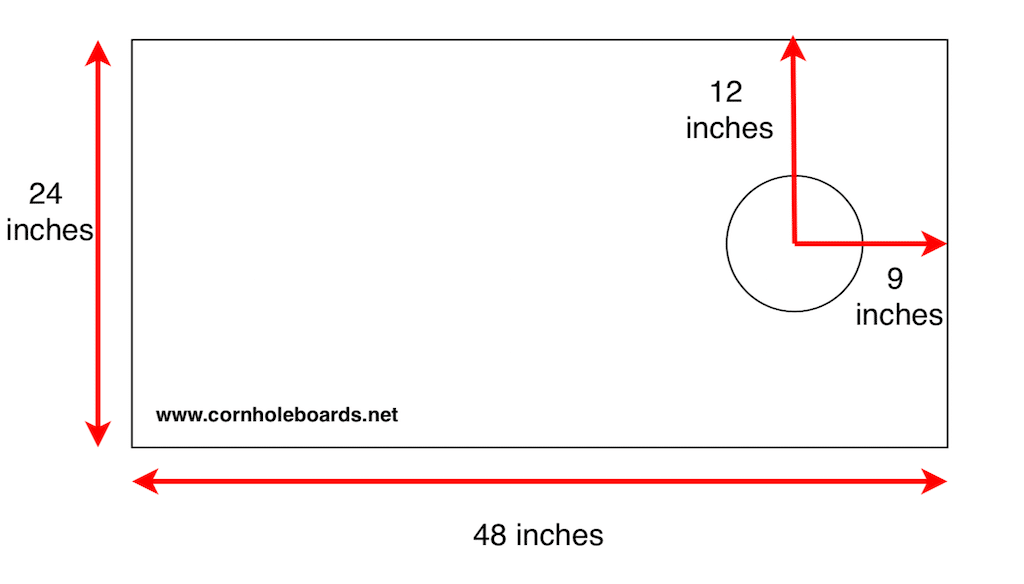
 The playing surface should be sanded and very smooth so that no blemished in the wood interfere with the gameplay.
The playing surface should be sanded and very smooth so that no blemished in the wood interfere with the gameplay.
The cornhole boards can be painted with a high gloss latex paint or varnish to allow for sliding. You just need to make sure that the boards aren’t so slippery that the bags slide right off of the board.
The ACA (which is a different cornhole organization known as the American Cornhole Association) prefers boards with no open sides. This is because some people could get confused if they see a cornhole bag underneath the cornhole board and they might think that there was a cornhole scored when really someone just made a bad throw that ended up located underneath the cornhole board.
If the sides to the cornhole board are closed, you know that if a bag is underneath the board, it only got there because it went through the cornhole.
You can read my guide on cornhole boards here.
Cornhole bags
You’ll need a total of eight bags so that each player or team has four bags to throw.
Cornhole bag dimensions
According to the ACO, cornhole bags should abide by the following standard:
- Each bag is made from two fabric squares with double-stitched seaming.
- The bags should be made from a durable fabric like canvas, twill, or synthetic suede.
- Each bag measures roughly 6” by 6” and weighs 15 to 16 ounces
Many people use duck cloth to construct their bags since that is very durable. Also, I know some people prefer to use triple-stitching instead of double-stitching since it makes the bags more durable.
You should note that if you use real corn-filled bean bags that corn will break down over time and it will lose weight. At the same time, you don’t want overstuffed bags that will be bouncing hard off the cornhole board.
There is debate as to whether or not you should use corn-filled bags or bags filled with plastic resin-pellets. I prefer the corn-filled bags because that’s the traditional way and I like the dust they produce that allows the bags to slide nicely on the playing surface.
Plastic resin pellet bags are usually weatherproof though and you don’t have to worry about them getting little critters on the inside so they don’t require as much maintenance. You can read more about the differences between these bags here.
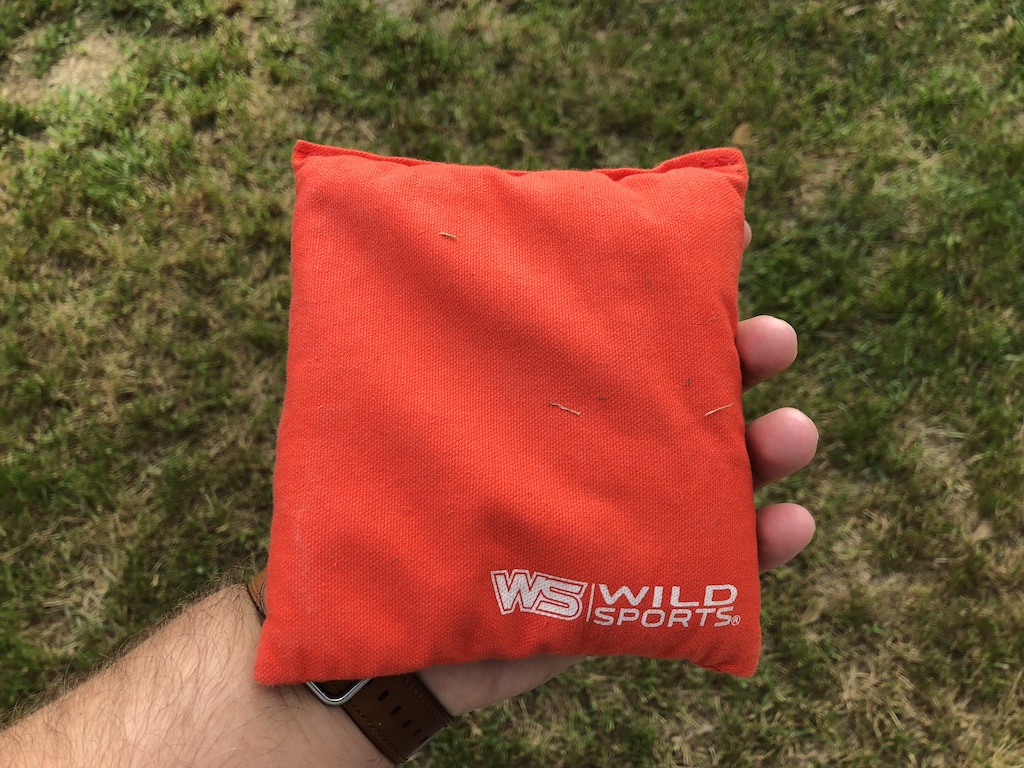
Cornhole gameplay
Cornhole game play is very simple and you can read more on how to play cornhole here.
1 on 1
In 1 on 1 cornhole, each of the two players will stand in the pitchers boxes on the same side. The cornhole board in between them is called the “headboard” and the cornhole board they are throwing to is called the “footboard.”
The players will alternate pitches until each player has thrown all four of their bags.
After all of the bags are thrown, the score is calculated (more on that below) and then the players will walk down to the other cornhole board and repeat the process. Once the final bag comes to a rest, each player has 30 seconds to walk to the other end, pick up their bags, and get ready to make their pitches.
The player with the higher score will throw first and they will resume tossing their four bags. During the entire game, each player remains in their own lane.

2 on 2
In 2 on 2 play, each team remains in their lane the entire game and the play is almost the exact same as described above.
The main difference is that the players never walk down to the other board since the those boards are already occupied by their team mates. So the players on each side just pick up the bags after the score is taken and then make their pitches to the other side. Rinse and repeat.
Once again, the team that score the most in that inning will go first the next inning. If neither player/team scores, the player/team who pitched first in the preceding frame shall retain first pitch in the next frame.
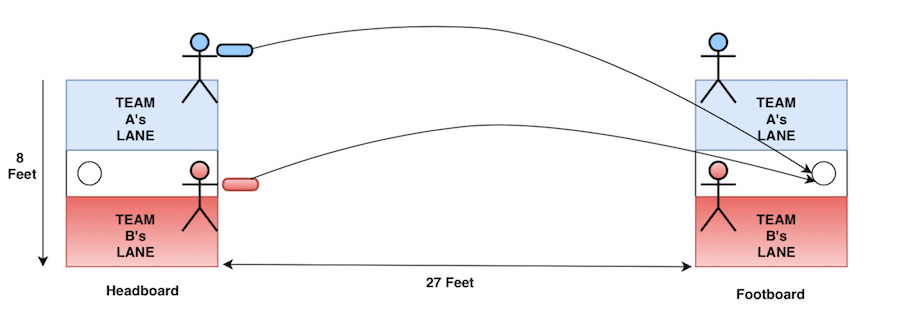
If you want tips for how to throw your cornhole bags then click here.
Get a quality cornhole board set right now!
Check out my #1 recommendation for a quality cornhole board set that is perfect for beginners.
Cornhole scoring
Cornhole scoring is a pretty simple process.
In cornhole you can score 3 points, 1 point, or 0 zero points on each toss. Here’s what counts as a point.
- Cornhole (3 points) — when the bean bags passes entirely through the cornhole
- Woodie (1 point) — when the bean bag lands on the playing surface of the cornhole board
- Foul (0 points) — any bean bags that is not a woody or a cornhole
(For a list of many other cornhole terms click here).
What counts as a woody?
When a bag lands directly on the playing surface, it’s clear that it’s a woody but what about when it’s hanging off?
If it’s hanging off the board but not touching the ground it’s a woody. Also, if it’s hanging partially over the hole but still remaining on the board, that’s a woodie.
What counts as a foul?
All of the following actions would be considered a foul.
- You step over the foul line (at least one foot or appendage must be completely inside the pitcher’s box at the time of release)
- Throw from the wrong pitcher’s box (many don’t follow this rule)
- A bag hits the ground — if a bag hits the ground and then makes its way on to the cornhole board, it’s a foul
- Lands on the ground — any bag that comes to rest touching the ground and the board is a foul.
- Hits something else besides the board — if your bag hits a tree, power line, ceiling, etc. then that it s a foul bag.
- Take too long to pitch — Any bag not pitched within the 15 second time limit is a foul bag.
The cancellation method
The official way to score cornhole is with the cancellation method.
With this method, only one team or player scores points each inning/frame.
So for example, let’s say a frame goes like this:
- TEAM A scores 2 cornholes and 1 woody so they get 7 points.
- TEAM B scores 3 cornholes and 2 woodies so they get 11 points.
In that case, you subtract the lower score from the higher score so that at the end of the frame, TEAM B has 4 points (11 minus 7) and TEAM A has 0 points.
Some people struggle to keep score during their games so they rely on things like cornhole scoreboards to help them out. There are tons of different types of score boards — my favorite are the ones that come with drink holders.
You can find out more about these and other cornhole accessories here.
Determining the cornhole winner
There are different ways to crown the cornhole winner. The preferred way most people play is that you play until one player reaches 21.
Some play whereas soon as that player or team hits 21 (even if it’s in the middle of the inning), they win. Others require all players and teams to get a chance to make their pitch.
Others play a little bit differently.
Some play where:
- Winner has to score exactly 21 and if you don’t then you go back to 15 or 11
- Winner has to win by two
- First one to 11 wins
I prefer playing where the first person to reach 21 wins as the games tend to be the perfect length of time — not too long or too short.
Many people play 7-0 skunks so if one player gets ahead 7 to zero, it’s declared a skunk and the player with zero points loses.
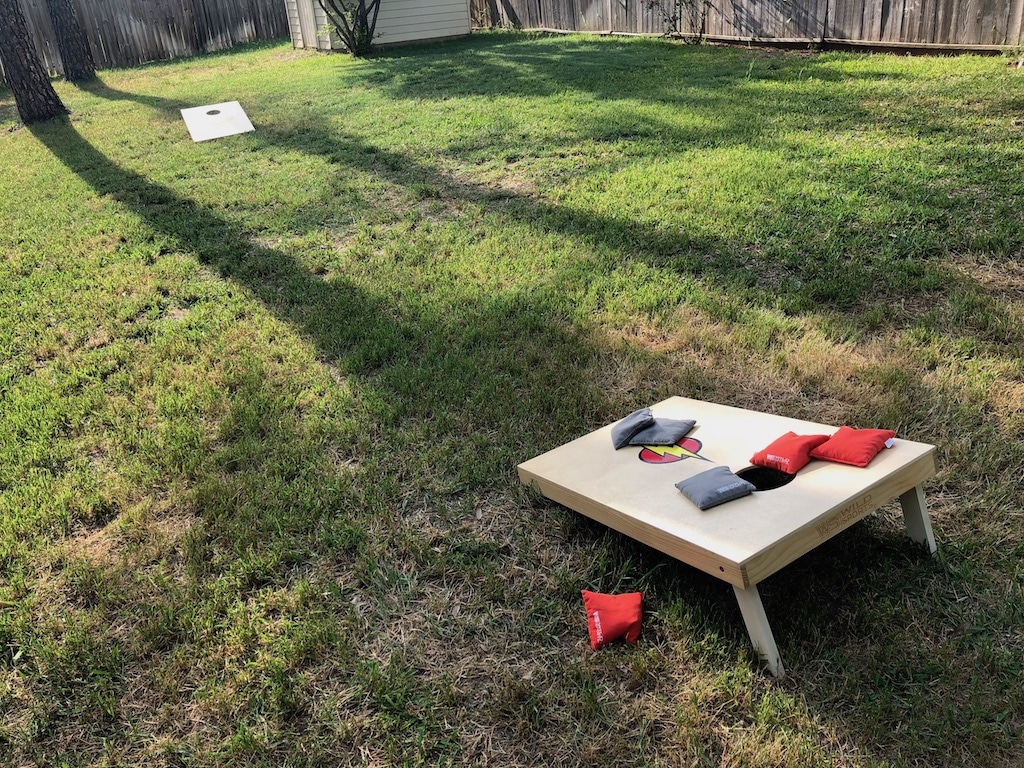
Cornhole tournament rules
When playing in official cornhole tournaments, there are specific rules for choosing things like the lanes, bean bag colors, and who goes first.
Seeded tournament rules
If you are playing in a seeded tournament then the following rules apply:
- The player/team with the higher seed has their choice of bag color.
- The player/team with the higher seed pitches first.
- In singles play, the player with the higher seed chooses lane assignments
If you’re playing doubles then the higher seed get to choose one of the following options:
- Option #1: Choose lane assignments
- Option #2: Choose their opponent to pitch against (head-to-head)
If option #1 is selected, the higher seed chooses their lane and takes their positions in the Pitcher’s boxes, then the lower seeded team chooses their own Pitcher’s boxes to determine head-to-head match-ups.
If option #2 is selected, the lower seed chooses their lane and takes their positions in the Pitcher’s boxes, then the higher seeded team will choose their own Pitcher’s boxes to determine head-to-head match-ups.
If playing best 2 out of 3 matches, the First Pitch and Pre-Match options go to the higher seed in game #1 and to the lower seed in game #2. If there needs to a third game then the options return to the higher seed to choose.
Randomly seeded tournament rules
- The player/team winning the coin-toss chooses their bag color.
- The player/team winning the coin-toss pitches first.
- In singles play, the player winning the coin toss chooses their lane assignment.
In doubles play, a coin-toss is used to determine which player/team selects one of the following options:
- Option #1: Choose the lane assignments
- Option #2: Choose their opponent to pitch against (head-to-head)
If option #1 is selected, the coin toss winner chooses their lane and takes their positions in the Pitcher’s boxes, then the opposing team chooses their own Pitcher’s boxes to determine head-to-head match-ups.
If option #2 is selected, the coin toss loser chooses their lane and takes their positions in the Pitcher’s boxes, then the coin toss winner will choose their own Pitcher’s boxes to determine head-to-head match-ups.
If playing best 2 out of 3 matches, the First Pitch and Pre-Match option choices go to the coin toss loser in the second game. If a third game is necessary, another coin toss will decide who has the options.
Custom cornhole tournament brackets
If you need custom tournament brackets, whether for single elimination or double elimination, you can find those here.
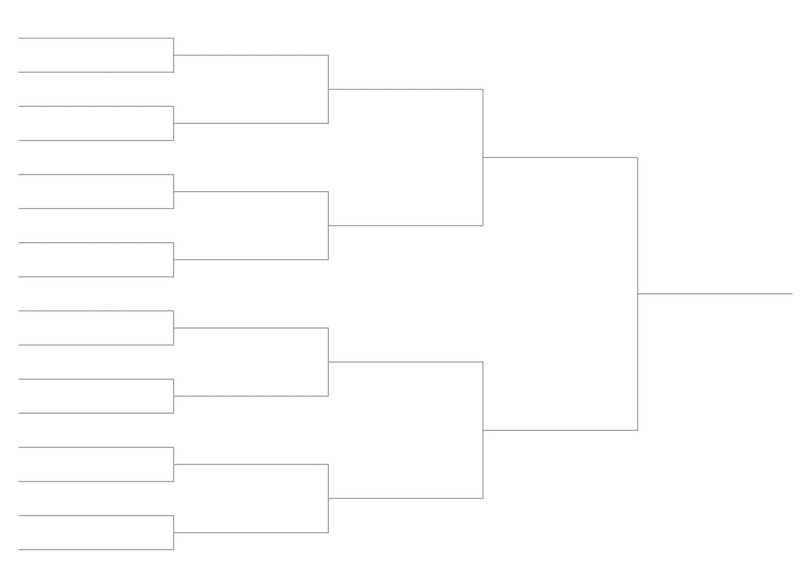
Raking and sweeping the cornhole bags
In cornhole, there are rules that allow you to clear away the bags so that they don’t interfere with the game play.
Raking cornhole bags
If the bean bags get piled inside the cornhole board, they could interfere with the game play by not allowing a bean bag to fall through the hole. To prevent this, a player may request a rake, where the bags that have fallen inside the cornhole board are removed.
- To request a rake, the player must audibly ask.
- One or both players may walk to the other board and rake the bags from under the board
- A third party may be asked to rake the bags if the players agree.
- A certified official may be called to rake the bags if a discrepancy is in question.
Anytime four cornhole bags have entered the hole or you can visibly see the bags piled through the hole, a player can request a rake without being charged a time out.
It’s very important to do your best to not affect any cornhole bags on the playing surface when raking. If there are bags on the rim of the hole but they are not touching any of the bags piled on the inside, they should not be moved.
But if a bag is on the rim and touching the piled bags, it’s okay if the bag falls in when the bags are raked. In that case, the bag is considered a cornhole worth 3 points.
Sweeping cornhole bags
If a foul bag lands on the playing surface or comes to rest touching the ground and the board, it must be removed immediately.
If a player pitches a foul bag which affects any bags in play, their opponent has the option of returning all cornhole bags to their original position on the playing surface or leaving all bags as they are.
Get a quality cornhole board set right now!
Check out my #1 recommendation for a quality cornhole board set that is perfect for beginners.
Calling Timeouts
- Each player or team is allowed two 1 minute time outs per game.
- A player may only call a time out when it is his/her turn to pitch.
- Both players may walk to the other boards to examine bag position during the time out.
- Players may not touch the cornhole bags or boards during a timeout.
Miscellaneous cornhole rules
What if a foul bag hits the other bags?
You have two options here.
If someone pitches a foul bag and it affects any bags in play, their opponent can choose to return all cornhole bags to their original position on the playing surface or leave all bags as they are.
What if I drop my cornhole bag?
If you’ve already completed the final forward swing of the delivery process and the cornhole bag leaves your hand, then that is considered a pitched bag. That means that if it flies out of your hand and lands four feet in front of you — that’s a foul worth zero points.
However, if the bag is is accidentally dropped by a player before the final forward swing has started, it’s okay to just pick that bag right up and give it another shot.
What if I throw out of turn?
If someone throws their bag when it’s not their turn then it’s considered a foul.
If the out-of-turn bag affects any bags in play, once again the opponent has the option to return all of the bags to their original positions or simply leave them be.
However, if the out of turn player has already thrown two bags before anybody realizes the mistake, then the frame proceeds and those bags are not considered fouls.
Keeping the court clean
Players should make their best effort to keep the cornhole courts free of distractions and each player is responsible for making sure that the the cornhole court is in good playing condition. No player is allowed to alter the cornhole court during a tournament without consent from the opponent or an official.
Distractions
Players are not supposed to distract other players during the game. So it’s not okay to be jumping up and down and doing cartwheels over the board when the other team is trying to play.
When your opponent is pitching, you should be standing about two feet behind them so as not to interfere with their throw.
Drinking games
Cornhole can be a lot of fun on its own but if you’re playing at a party or a tailgate you might be interested in trying out a cornhole drinking game.
There are a number of different types of cornhole drinking games. I like the game where one player or team has to drink if they go above a designated number of fouls or if the other team stays below a certain number of fouls Both can be a lot of fun but there are many other cornhole drinking games that can be played.
Cornhole history
Cornhole has a very interesting and (unclear) history with disputed origins. The most likely explanation in my opinion is that it was invented by a Harvard grad in the late 1880s and eventually adapted into the game we play today.
Final word
These are all of the rules for cornhole. They are relatively straight forward and so there’s not a lot to learn. But sometimes situations can arise where it’s not clear what you should do like when someone drops a cornhole bag mid-toss.
These cornhole rules should help shed light on what to do in those instances and help you keep a nice, orderly and fun game of cornhole going.

